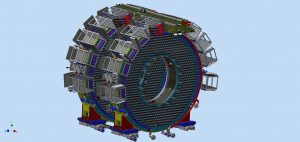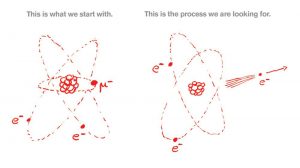
The interest of Particle Physics is increasingly focused on the search for the so-called New Physics beyond the Standard Model (SM), in order to understand and answer some fundamental questions that this model does not describe. According to the SM, muons decay into electrons with a 3-body decay: μ– → e–, anti-νe, νμ, in which the lepton number and lepton flavor between the initial and final state are preserved.Frascati National Laboratories participate in the design and construction of the Mu2e experiment at Fermilab (United States), which will start data taking in 2023.
Mu2e aims to study the process of direct conversion of a muon into an electron, in presence of an aluminum nucleus. This process violates the lepton flavor preservation and in the SM it is expected with a very low probability (<10-54). Therefore, the observation of this decay at the sensitivity of today’s experiments would be a clear signature of New Physics. There are already other theoretical models beyond the SM (Supersymmetry, Leptoquarks, Z’, etc.) which estimate this conversion to happen with a higher probability, around 10-16. To make a heuristic example, this is equivalent to the probability of having your home destroyed by a meteorite and struck by a lightning bolt in the next 3 months.

The importance of Mu2e results also lies in the complementarity of the research for the direct production of new particles (like at the LHC collider) and other measurements of lepton flavor violation (μ– → e– γ, μ– → e– e+ e–). Mu2e will investigate up to energy scales around thousands of TeVs, far above the mass values that can be produced by current accelerators.
The challenge of the experiment lies in the extreme rarity of the process. The experiment objective is to reach values of single event sensitivity equal to 3 x 10-17 that is 10,000 times better than the current measurement. To achieve this goal, the three fundamental components of the experimental apparatus are:
1) a pulsed and very high intensity beam of negative muons, produced through a proton beam hitting a tungsten target;
2) a superconducting magnetic system, for transporting and selecting muons;
3) a 12 m solenoid housing the aluminum target and detectors.

The 10 billion muons produced every second are stopped in the target and form muonic atoms with the muon in the 1S orbital. In 40% of cases, the muon decays, while in the remaining 60% of cases it is captured by the nucleus, producing a background of protons, photons and neutrons. In the rare case of a conversion event, a muon in 1S orbital turns into a “mono-energetic” electron with a momentum value very close to the muon mass at rest: ~ 105 MeV/c. The detector system must be very precise in order to distinguish the signal from the background. It consists of a straw tube tracker and a crystal calorimeter. The LNF Mu2e group plays a leading role in the INFN contribution to the experiment, guiding the design, the research and development phase and the construction of the electromagnetic calorimeter.
The calorimeter has to reconstruct the conversion electrons with an energy resolution of 10% and a timing resolution better than 500 ps. The detector consists of 2 disks, each one containing 674 pure Cesium Iodide (CsI) crystals, each read out by two UV-extended custom silicon photomultipliers (SiPM). A prototype made of 51 crystals has already been built and tested with an electron beam at LNF. The resulting performance fully meets the experiment requirements.
At the beginning of 2018, the production phase of the calorimeter started, focused on the characterization and quality control of all the components. The assembly of the first disk is going to start in Spring 2020. The installation of the entire detector inside the experimental apparatus will follow in 2021.
 INFN-LNF Laboratori Nazionali di Frascati
INFN-LNF Laboratori Nazionali di Frascati